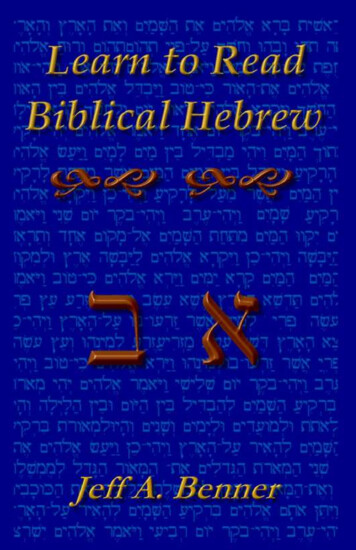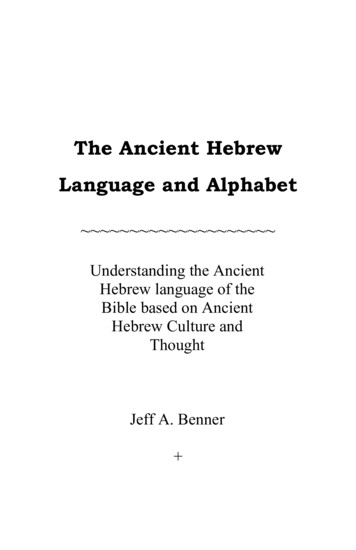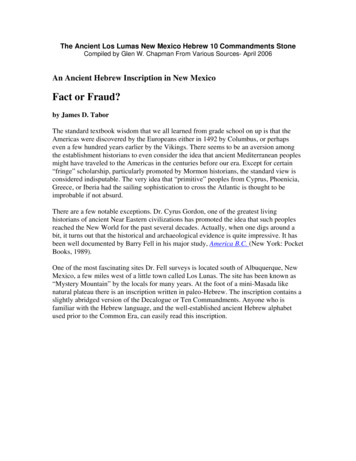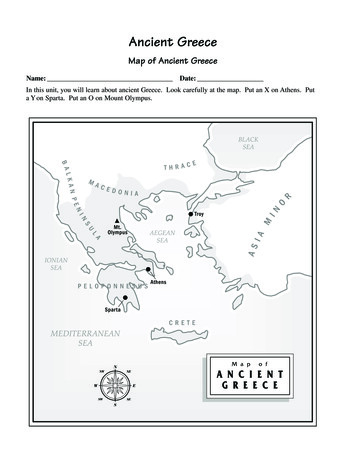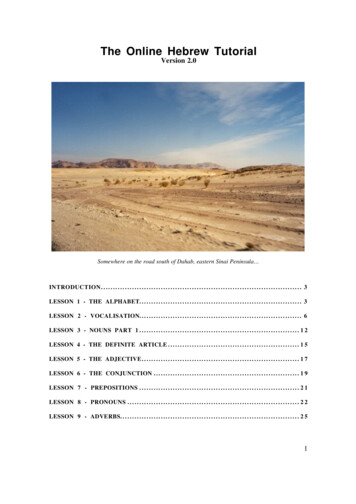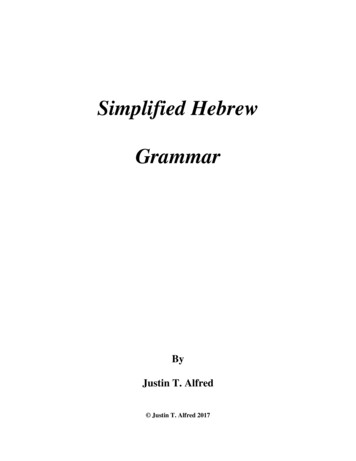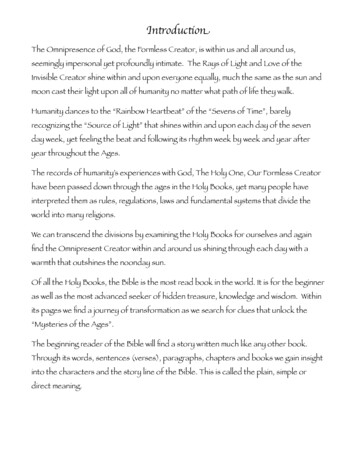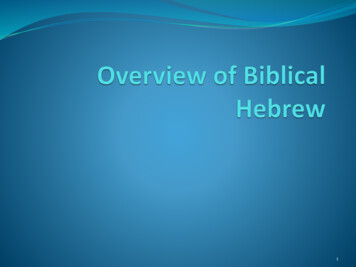Transcription
The Ancient HebrewLexicon of the Bible Hebrew Letters, Words andRoots Defined Within TheirAncient Cultural ContextJeff A. Benner
The Ancient Hebrew Lexicon of the BibleCover design by Jeff A. Benner. Ancient Inscription photo taken at the University ofPennsylvania, Museum of Archeology and Anthropology by the author. The inscriptionreads "Sh'ma" meaning hear (see Duet 6.4) and is inscribed on a piece of brokenpottery dated 586 to 450 BCE.Copyright 2005 Jeff A. BennerAny part of this book may be copied for non-profit educational purposes only, withoutprior permission.3
The Ancient Hebrew Lexicon of the BibleAcknowledgmentsI would first like to thank my wife Denise for her patience andencouragement. I am extremely blessed to have been privileged with heras a gift from above and the one who has been my continual companionand confidant. She has always supported me in this endeavor andallowed me the space and time for research and writing. Without herdevotion and inspiration this work would never have come to fruition.I am also grateful to Dr. Larry S. Hirsch. Without his initial introductioninto Hebrew thought and language and his instruction in Biblical studiesI would never have started this journey into the Ancient Hebrew thought,culture and language.Also my friend Michael Calpino who continually supported my studiesin the Hebrew language, listened to my discoveries and assisted me byworking out many word and root origins and meanings.I would also like to thank the hundreds of people who have supportedmy work at the Ancient Hebrew Research Center Website with theirsuggestions, corrections and encouragement.There are also many great Hebrew scholars who, with their research andwork, have laid the foundations for me and others interested in theHebrew culture and language who are much deserving of our thanks.4
The Ancient Hebrew Lexicon of the BibleTABLE OF CONTENTSACKNOWLEDGMENTS. 4INTRODUCTION . 9PURPOSE OF THE LEXICON . 9The written word . 9The word meaning . 9Where is the Hebrew? . 9The original Hebrew . 9PERSPECTIVE OF THE LEXICON . 10WEBSITE . 11ANCIENT HEBREW THOUGHT. 12ABSTRACT AND CONCRETE . 12APPEARANCE AND FUNCTIONAL DESCRIPTIONS . 13STATIC AND DYNAMIC . 14THE ANCIENT HEBREW ALPHABET. 15EVOLUTION OF THE HEBREW ALPHABET . 15THE AYIN AND GHAH . 17One Word - Two Meanings . 17Greek Transliterations of the Ghah . 18Impact on Ancient Hebrew Studies. 18THE SAMECH, SHIN AND SIN . 19RECONSTRUCTION OF THE ORIGINAL HEBREW ALPHABET . 19Letter Characteristics . 20THE RECONSTRUCTED ALPHABET. 21AL . 21BET . 22GAM . 23DAL . 23HEY . 24WAW . 24ZAN . 25HHETS. 26THET . 26YAD . 27KAPH . 27LAM . 285
The Ancient Hebrew Lexicon of the BibleMAH . 28NUN . 29SIN. 29AYIN . 30PEY . 30TSAD. 31QUPH . 31RESH . 32SHIN . 32TAW. 33GHAH . 33HEBREW ALPHABET CHART . 34THE HEBREW ROOT SYSTEM . 35PARENT ROOTS. 35CHILD ROOTS . 35ADOPTED ROOTS . 36RECONSTRUCTION OF ROOTS . 37THE HEBREW LANGUAGE . 38VERBS . 38Person . 38Number . 38Gender . 38Tense . 38Voice. 39Mood . 39Verb Conjugations . 39NOUNS . 40Noun Derivatives. 40Feminine Derivatives . 40Combination Derivatives . 40Plural Nouns . 40Grammatical Tools. 41DETERMINING THE ORIGINAL MEANING OF HEBREW WORDS . 41LETTER EVOLUTION . 42ANCIENT HEBREW PRONUNCIATION . 43Spirants and Stops . 43Vowels . 43Syllables. 43Masoretic Vowels . 44Transliterations . 45LEXICON FORMAT . 46PARENT AND ADOPTED ROOT FORMAT . 46CHILD ROOT FORMAT . 476
The Ancient Hebrew Lexicon of the BibleWORD FORMAT . 48THE LEXICON . 50PARENT AND CHILD ROOTS . 51Al . 51Bet . 63Gam . 78Dal. 89Hey . 101Waw. 108Zan . 110Hhets . 118Thet . 135Yad . 141Kaph . 145Lam . 156Mah . 166Nun . 180Sin . 194Ayin . 207Pey. 219Tsad . 230Quph . 242Resh . 254Shin . 272Taw. 290Ghah . 297ADOPTED ROOTS (THREE LETTER) . 302Al . 302Bet . 304Gam . 313Dal. 321Zan . 325Hhets . 330Thet . 349Kaph . 352Lam . 362Mah . 367Nun . 374Sin . 389Ayin . 400Pey. 414Tsad . 425Quph . 432Resh . 441Shin . 4527
The Ancient Hebrew Lexicon of the BibleTaw. 470Ghah . 473ADOPTED ROOTS (FOUR LETTER) . 475FOREIGN WORDS . 482INDEXES . 484ENGLISH DEFINITIONS . 484KING JAMES TRANSLATION . 506STRONG'S NUMBER . 556ALTERNATIVE SPELLINGS . 578NOTES . 6138
The Ancient Hebrew Lexicon of the BibleIntroductionPurpose of the LexiconIn order to demonstrate the need for an Ancient Hebrew lexicon let us examine theword (halel), how it is written and what it means.The written wordThe Hebrew word , as it appears here, in Hebrew dictionaries and in HebrewBibles, is written with the Modern Hebrew script. But where did the Modern Hebrewscript come from? Hebrew was originally written with a pictographic script similar toEgyptian Hieroglyphs but, when Israel was taken into captivity in Babylon theyadopted the Aramaic script of the region and used it to write Hebrew. The ModernHebrew script used today is in fact Aramaic in origin, not Hebrew.The word meaningAccording to Hebrew dictionaries and lexicons the word is translated as "praise".The Ancient Hebrew language is a concrete oriented language meaning that themeaning of Hebrew words are rooted in something that can be sensed by the five sensessuch as a tree which can be seen, sweet which can be tasted and noise which can beheard. Abstract concepts such as "praise" have no foundation in the concrete and are aproduct of ancient Greek philosophy.Where is the Hebrew?If the word is written with the Aramaic script and the definition "praise" is fromthe Greek, where is the Hebrew in this word? The purpose of the "Ancient HebrewLexicon of the Bible" is to restore the original Hebrew to the Hebrew language of theBible.The original HebrewThe word would have been written as in the Early Hebrew script (over 3200years ago) or as in the Middle Hebrew script (between 3200 and 2500 years ago).The original pictographic letters of the parent root is a man with his arms raised"looking" at something spectacular and a shepherd staff that is used to move the flock9
The Ancient Hebrew Lexicon of the Bible"toward" a place. When these are combined the idea of "looking toward" something isrepresented. The original meaning of is the North Star, a bright light in the nightsky that is "looked toward" to guide one on the journey.If we are going to read the Bible correctly it must be through the perspective of theAncient Hebrews who wrote it, not from a Modern Aramaic or Greek perspective. Theword in its original concrete meaning is a bright light that guides the journey andwe "praise" Yah by looking at him to guide us on our journey through life.Perspective of the LexiconThe first and foremost concept that a reader of the Biblical text must learn is that theancient Hebrews were products of an eastern culture while you as the reader are theproduct of a western culture. These two cultures are as different as oil and vinegar, theydo not mix very well. What may seem rational in our western minds would beconsidered irrational to an easterner of an ancient Near East culture. The same is true inthe reverse, what may be rational to an ancient Easterner would be completely irrationalin our western mind.The authors of the Biblical text are writing from within their culture to those of thesame culture. In order to fully understand the text one needs to understand the cultureand thought processes of the Hebrew people.All existing Hebrew Lexicons of the Bible convert the vocabulary of the ancientHebrews into a vocabulary compatible to our modern western language. The greatestproblem with this is that it promotes western thought when reading the Biblical text. Inthis Lexicon the mind of the reader is transformed into an eastern one in order tounderstand the text through the eyes of the ancient Hebrews who penned the words ofthe Bible.One of the greatest differences between this lexicon and others is the use of the ancientpictographic script which Hebrew was originally written in. Because the AncientHebrew language is based on these pictographs, they are used rather than the ModernHebrew script.10
The Ancient Hebrew Lexicon of the BibleWebsiteThe Ancient Hebrew Lexicon of the Bible has its own website with additional materialand information such as verb charts, listing of Biblical Hebrew words in order of theirfrequency, common Hebrew roots and updates to the lexicon and much more. Theauthor is also available for questions, comments and requests.Ancient Hebrew Lexicon of the Bible websitehttp://ahlb.ancient-hebrew.org11
The Ancient Hebrew Lexicon of the BibleAncient Hebrew ThoughtThe definition of a word is going to be directly related to the culture in which that wordis being used. One word may have different meanings depending on the culture that isusing it. In order to place the correct context to a Hebrew word from the AncientHebrew language one must first understand Ancient Hebrew thought.Abstract and ConcreteGreek thought views the world through the mind (abstract thought). Ancient Hebrewthought views the world through the senses (concrete thought).Concrete thought is the expression of concepts and ideas in ways that can be seen,touched, smelled, tasted or heard. All five of the senses are used when speaking,hearing, writing and reading the Hebrew language. An example of this can be found inPsalms 1:3; “He is like a tree planted by streams of water, which yields its fruit inseason, and whose leaf does not wither”. In this passage the author expresses histhoughts in concrete terms such as; tree, streams of water, fruit and leaf.Abstract thought is the expression of concepts and ideas in ways that cannot be seen,touched, smelled, tasted or heard. Examples of Abstract thought can be found in Psalms103:8; “The LORD is compassionate and gracious, Slow to anger, abounding in love”.The words compassion, grace, anger and love are all abstract words, ideas that cannotbe experienced by the senses. Why do we find these abstract words in a passage ofconcrete thinking Hebrews? Actually, these are abstract English words used to translatethe original Hebrew concrete words. The translators often translate this way because theoriginal Hebrew makes no sense when literally translated into English.Let us take one of the above abstract words to demonstrate the translation from aconcrete Hebrew word to an abstract English word. Anger, an abstract word, is actuallythe Hebrew word (aph) which literally means “nose”, a concrete word. When oneis very angry, he begins to breathe hard and the nostrils begin to flare. A Hebrew seesanger as “the flaring of the nose (nostrils)”. If the translator literally translated theabove passage “slow to nose”, the English reader would not understand.12
The Ancient Hebrew Lexicon of the BibleAppearance and Functional DescriptionsGreek thought describes objects in relation to its appearance. Hebrew thought describesobjects in relation to its function.A Greek description of a common pencil would be; "it is yellow and about eight incheslong". A Hebrew description of the pencil would be related to its function such as "Iwrite words with it". Notice that the Hebrew description uses the verb "write" while theGreek description uses the adjectives "yellow" and "long". Because of Hebrew's formof functional descriptions, verbs are used much more frequently then adjectives.To our Greek way of thinking a deer and an oak are two very different objects and wewould never describe them in the same way. The Hebrew word for both of these objectsis (ayil) because the functional description of these two objects are identical tothe Ancient Hebrews, therefore, the same Hebrew word is used for both.The Hebraic definition of is "a strong leader". A deer stag is one of the mostpowerful animals of the forest and is seen as "a strong leader" among the other animalsof the forest. The wood of the oak tree is very hard compared to other trees and is seenas a "strong leader" among the trees of the forest.Notice the two different translations of the Hebrew word in Psalms 29:9. TheNASB and KJV translates it as "The voice of the LORD makes the deer to calve" whilethe NIV translates it as "The voice of the LORD twists the oaks". The literal translationof this verse in Hebrew thought would be; "The voice of the LORD makes the strongleaders turn ".When translating the Hebrew into English, the Greek thinking translator will give aGreek description to this word for the Greek thinking reader, which is why we have twodifferent ways of translating this verse. This same word "ayil” is also translated as a"ruler" (a strong leader of men) in 2 Kings 24.15.Ancient Hebrew will use different Hebrew words for the same thing depending upon itsfunction at the time. For example an ox may be identified as an (aluph) whenreferring to a lead ox, a (shor) when referring to a plow ox, (baqar) whenreferring to an ox of the field or (par) when referring to an ox of the threshingfloor.13
The Ancient Hebrew Lexicon of the BibleStatic and DynamicIn our Modern western language verbs express action (dynamic) while nouns expressinanimate (static) objects. In Hebrew all things are in motion (dynamic) including verbsand nouns. In Hebrew sentences the verbs identify the action of an object while nounsidentify an object of action. The verb (malak) is "the reign of the king" while thenoun (melek) is the "the king who reigns". A mountain top is not a static objectbut the "head lifting up out of the hill". A good example of action in what appears to bea static passage is the command to "have no other gods before me" (Exodus 20:3). InHebrew thought this passage is saying "not to bring another one of power in front of myface".14
The Ancient Hebrew Lexicon of the BibleThe Ancient Hebrew AlphabetEvolution of the Hebrew AlphabetThe Hebrew alphabet was written with a script belonging to the Semitic family oflanguages. The Semitic script followed three basic stages of development, Early,Middle and Late.The Early Semitic script was pictographic (fig. 1) where each letter represented anobject. In figure 1, the top left corner letter is a picture of water representing the sound“M”. The second letter from right at the bottom is a picture of a shepherd staffrepresenting the sound “L”.The Middle Semitic script (fig. 2) is an evolved form of the original pictographic scriptinto a simpler form and used by the different Semitic groups including the Hebrews(fig. 2), Moabites (fig. 3), Ammonites (fig. 4), Arameans (fig. 5) and others.The Aramaic script of the Arameans in Babylon evolved into the Late Semitic scriptindependently from other Semitic scripts (fig. 6). When the Hebrew people were takeninto Babylonian captivity, they adopted the Aramaic script (fig. 7) and is still in usetoday (fig. 8).While the majority of the Hebrew texts of the first century BCE and into the firstcentury CE were written in the Late Semitic or Aramaic script, the Middle Semiticscript was not lost. It was still used on occasion such as on many of the Jewish coins aswell as some religious scrolls such as those found in the Dead Sea caves (fig. 9).The Samaritans lived in the land of Samaria, a region of Israel, at the time of Israel'scaptivity; they were not taken into Babylon with Israel. As a result of their isolationthey are the only culture to retain a script (fig. 13) similar to the Middle Semitic scriptand is still used to this day in the Samaritan community.Around 1000 BCE, the Greeks adopted the Middle Semitic script (fig. 11) and began toevolve independently over the centuries to become the Greek script (fig. 12) usedtoday.15
The Ancient Hebrew Lexicon of the BibleFigure-2 Ancient Hebrew inscriptionon potsherd c. 900 BCEFigure-1 Ancient Semitic pictographicinscription on stone boulder c. 1500 BCEFigure-4 Ammonite inscription onstone c. 900 BCEFigure-3 Moabite inscription on stone c.900 BCEFigure-5 Aramaic inscription on stoneincense altar c. 500 BCEFigure-6 Aramaic inscription onstone plaque c. 20 CE.Figure-8 Modern Hebrew script fromthe Hebrew Bible.Figure-7 Hebrew writings from the DeadSea Scrolls c. 200 BCEFigure-10 Samaritan scriptsFigure-9 Pictographic Hebrew writingsfrom the Dead Sea Scrolls c. 100 BCEFigure-12 Greek writing on NewTestament papyrus c. 200 CEFigure-11 Greek inscription found onbowl c. 800 BCE16
The Ancient Hebrew Lexicon of the BibleThe Ayin and GhahWhile the Modern Hebrew alphabet consists of twenty-two letters, the evidencesuggests that there were additional letters in the original Semitic and Hebrew alphabet.One of the ancient Semitic languages of Canaan was Ugarit. This
The Ancient Hebrew Lexicon of the Bible 11 Website The Ancient Hebrew Lexicon of the Bible has its own website with additional material and information such as verb charts, listing of Biblical Hebrew words in order of their frequency, common Hebrew roots and u

